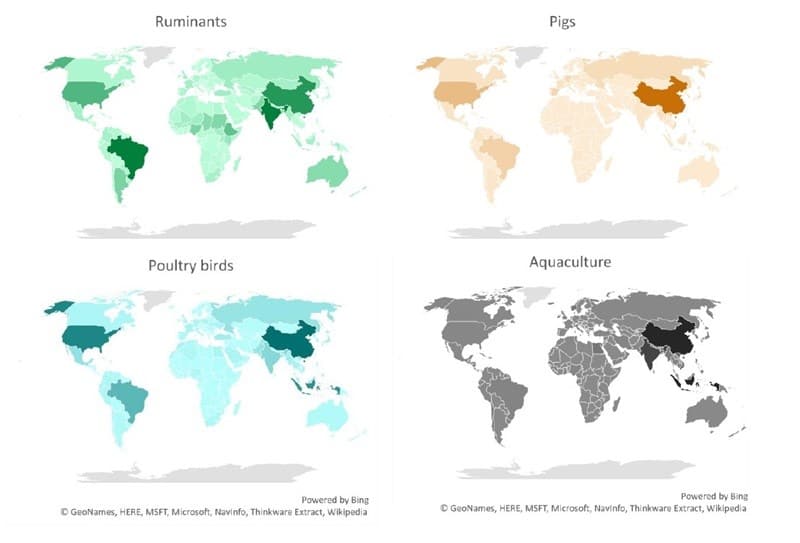Customer Logins
Obtain the data you need to make the most informed decisions by accessing our extensive portfolio of information, analytics, and expertise. Sign in to the product or service center of your choice.
Customer Logins
BLOG
Feb 07, 2020
Blog: Fine tuning nutrients in animal feed is key to improving farming productivity
Phosphorus is an essential element for the biological development of both plants and animals. When looking at animals specifically, phosphate-based compounds have many different roles (e.g. energy storage via ATP and lipids), yet the major role is to encourage fast and strong development of bone structure.
Animals have been bred and raised successfully well before the advent of the market for chemically-produced feed phosphates, as significant amounts of phosphorus are already naturally available in animal diets. Centuries of agronomic studies, which continue to this day, have continuously added to the knowledge bank of livestock farmers and animal nutritionists, crucially in one aspect: optimal calcium-to-phosphorus (Ca:P) ratios to ensure high livestock yields. Within the realm of animal nutrition studies, the Ca:P ratio is one of the variables that attracted the firmest research interest - a testament to its commercial significance.
In short: phosphorus is essential, and although feed-grade phosphates are not the only source of digestible phosphorus to animals they remain an essential and necessary component of proper animal nutrition - particularly for commercial-scale livestock farming.
The market for feed-grade phosphates is considerably smaller in size (on a phosphate basis) compared to fertilizer-grade products: we estimate about 3.5 million tonnes P2O5 for feed-grade compared to 48 million tonnes for fertilizer-grade phosphates). Nonetheless, while relatively small in size, the market for feed-grade phosphates is a very important driver of merchant demand for phosphoric acid in various areas, notably in Europe, Turkey, Southeast Asia, Brazil, Mexico to name some of the most important markets.
On a species level there is a strong contribution from ruminants in total dietary phosphorus requirements and poultry birds also contribute significantly to the total, mainly thanks to their widespread farming throughout most geographies and cultures -they are also the most widely farmed animal in the developing world, where most of the potential for improvements in the Ca:P dietary ratio lies. Pigs are also relatively phosphorus-intensive animals, although they are farmed on a relatively smaller scale on a global level due to cultural limitations (e.g. in Muslim and Jewish populations) and larger dietary requirements that make them not affordable to very-small-scale farmers. Aquaculture has also been a significant driver of demand growth in areas such as Latin America and Asia (particularly Southeast Asia), and importantly presents a firm preference for product varieties exhibiting a higher water solubility, such as MCP or feed-grade MAP.
The Geography of Digestible Phosphorus by Species Class, 2018

In today's market conditions, supply & demand modelling for phosphate feed additives is of particular interest to many companies aiming at investing either in additional merchant phosphoric acid capacity (for which the feed industry would be an important demand-side factor) or directly in feed-grade phosphate capacity. Feed-grade phosphate producers are also important contributors to import demand for phosphate rock.
For in-depth analysis of the feed phosphates market, including cost analysis and forecasting for supply, demand and prices download the sample pages to our latest 167-page report 'Fertecon: Animal Feed Phosphates Outlook to 2030'
This article was published by S&P Global Commodity Insights and not by S&P Global Ratings, which is a separately managed division of S&P Global.
{"items" : [
{"name":"share","enabled":true,"desc":"<strong>Share</strong>","mobdesc":"Share","options":[ {"name":"facebook","url":"https://www.facebook.com/sharer.php?u=http%3a%2f%2fwww.spglobal.com%2fcommodityinsights%2fen%2fci%2fresearch-analysis%2ffine-tuning-nutrients-animal-feed-key-improving-farming.html","enabled":true},{"name":"twitter","url":"https://twitter.com/intent/tweet?url=http%3a%2f%2fwww.spglobal.com%2fcommodityinsights%2fen%2fci%2fresearch-analysis%2ffine-tuning-nutrients-animal-feed-key-improving-farming.html&text=Blog%3a+Fine+tuning+nutrients+in+animal+feed+is+key+to+improving+farming+productivity+%7c+S%26P+Global+","enabled":true},{"name":"linkedin","url":"https://www.linkedin.com/sharing/share-offsite/?url=http%3a%2f%2fwww.spglobal.com%2fcommodityinsights%2fen%2fci%2fresearch-analysis%2ffine-tuning-nutrients-animal-feed-key-improving-farming.html","enabled":true},{"name":"email","url":"?subject=Blog: Fine tuning nutrients in animal feed is key to improving farming productivity | S&P Global &body=http%3a%2f%2fwww.spglobal.com%2fcommodityinsights%2fen%2fci%2fresearch-analysis%2ffine-tuning-nutrients-animal-feed-key-improving-farming.html","enabled":true},{"name":"whatsapp","url":"https://api.whatsapp.com/send?text=Blog%3a+Fine+tuning+nutrients+in+animal+feed+is+key+to+improving+farming+productivity+%7c+S%26P+Global+ http%3a%2f%2fwww.spglobal.com%2fcommodityinsights%2fen%2fci%2fresearch-analysis%2ffine-tuning-nutrients-animal-feed-key-improving-farming.html","enabled":true}]}, {"name":"rtt","enabled":true,"mobdesc":"Top"}
]}
